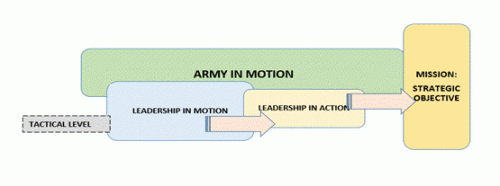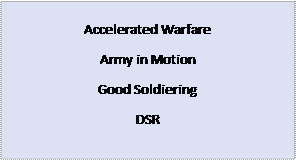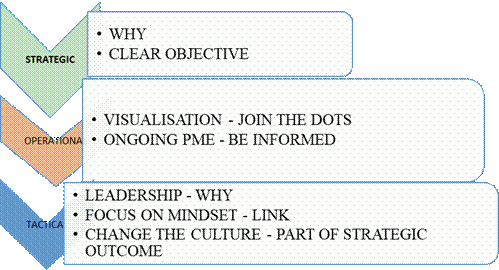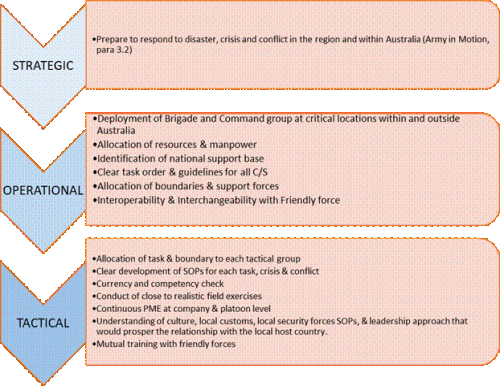Australian Defence Force (ADF) is an establishment entrusted by the government to do the most difficult and challenging task – to protect the sovereignty of our country. ADF HQ was established in 2017 and provides a system of governance for ADF to provide an effective integration of three services for planning, development, and conduct of operation. The release of the Defence Strategic Review (DSR) last year has guided us to concentrate on emerging threats and providing a new strategic focus for the ADF. The DSR outlines strategic objectives, however, it is up to commanders and leaders at various levels to articulate a clear guidance, systematic approach, and timely execution to achieving these goals as required at their respective levels. Therefore, it falls greatly on junior commanders and leaders at section and platoon levels to have a clear understanding of these strategic goals and be creative in translating this strategic focus to something tangible that our soldiers can visualise and aim for.
The Army’s concept of Accelerated Warfare and Army in Motion are other critical documents that need to be clearly understood at the junior level. Army in Motion has highlighted the five Ps – People, Preparedness, Profession, Potential, and Partnership in order to provide continuity with the task that we are currently engaged and performing well in the future, where army is looking to transform[1]. It highlights the requirement for the balanced transition from now to the future in individuals, teams, concepts, and equipment. During this transition period, it is critical that our junior leaders have a clear understanding of these concepts.
Leadership in Motion is a dynamic approach that is flexible, agile, uses combination of conventional and unconventional methods, focuses on strategic outcomes and build connection with the tactical action, provides proactive engagement, mission-focussed but flexible in execution, and stresses on adaptability. It is about continuously evolving, adapting and responding to the changing situations and is critical to shape the combat mindset of our personnel at the ground level, so that they are prepared with greater level of situational awareness. Additionally, there is also need to disintegrate the prevailing culture among our soldiers that “I am just a private”, which undermines their importance. It is essential to make them realise that they play a crucial role in the security of their country by delivering their role which, directly impacts at the strategic level. This is directly related to one of our defence value “Service” and therefore this connection needs to be established, highlighted and reinforced thoroughly.
The article intends to highlight that greater discussion is required about the concept of “Leadership in Motion” at the ground level to achieve outcomes desired by Army in Motion and the DSR. The key concept that needs to be discussed in Leadership in Motion is how to set up a flexible mindset of our personnel with specific mission-orientated approach that builds connection between a strategic outcome and a tactical action. Additionally, it should also focus in redefining the prevailing culture in to “I am more than just a Private”.
The first step to achieving this is to have a good understanding of the desired strategic outcomes at section and platoon commanders’ levels and build a connection between the higher objectives and tactical action. On the contrary, there might be argument regarding the necessity of understanding strategic focus at section level. However, it is argued that greater understanding leads to increased adaptability and responsiveness. Therefore, it is critical to encourage junior leaders to understand this concept and propel them to being creative in achieving specific mission at the tactical level, which will assist in achieving the strategic objectives. Furthermore, Leadership in Motion plays a critical role in balancing the transition by managing the expectations of individuals, setting a realistic goals and expectations, and encouraging a flexible and agile combat mindset in our personnel. If our people are our most critical assets, then we should focus more on the mindset of our people. This should be the primary goal.
Figure 1 below highlights the relationship between Army in Motion, Leadership in Motion, and strategic objectives. The central idea is to understand the concept of Army in Motion, and apply Leadership in Motion at the junior commanders’ level to target specific outcomes that are connected with the strategic goal. Therefore, the crucial link is setting up that flexible but broader combat mindset of our personnel by establishing a relationship between tactical action and strategic outcomes. The below paragraphs will discuss some factors that play critical roles in defining Leadership in Motion.

“Why” Good Soldering: Proactive Engagement
Good Soldering is about forging that trust to create successful teams[2]. This is an excellent way to prepare to have a ready mindset for combat. While doing so, it is important to examine the “WHY” we are practicing good soldering. Therefore, the required outcome at the tactical level needs to be linked with the aimed strategic objective, giving soldiers a visualisation of what is required and why. It is important that junior leaders clearly understand the strategic objectives highlighted in the DSR, Army in Motion, and other critical strategic documents. This falls greatly on their Chain of Command to ensure that their junior leaders are consistently engaged, informed, and challenged through professional military education. The constant engagement provides junior leaders a broader understanding of global geopolitics and could enable them to realize the “WHY” component of leadership. This could assist them establishing the connection between tactical action and strategic objectives. Subsequently, it will assist junior leaders to reinforce the concept of “Good Soldering” to their troops by highlighting the importance of their actions and the consequences at the higher level. It is critical for a soldier to visualise the connection and clearly understand to ensure they are in the right mindset, and will execute the mission by abiding by the law of all conflicts.
Establish to Visualise:
One of the other ways to establish the connection between a tactical action and the strategic objectives is to use the systematic breakdown of the strategic objective into sub-components that are tangible at the operation and tactical level. Having tangible tasks at the tactical and below help junior commanders to understand the effect of their actions at the strategic level. Figure 2 and 3 below briefly summarize the connection from strategic to tactical and lays out sub-components that become more tangible at the lower level. This also explains to our junior commanders the concept of “WHY”, which will enable them to make our soldiers understand and realise the importance and relevance of Army in Motion and DSR. It can be argued that this systematic breakdown of strategic objectives into operational and tactical, making it more comprehensible and tangible to a soldier is one of the key concepts of Leadership in Motion. A combination of understanding “Why” with an understanding of tangible tasks and their connections with strategic parameters promotes an open, flexible, and curious mindset, which is key in setting that flexible combat mindset.



Flexible Combat Mindset – Adaptability
The “Why” component and “Visualisation” create a mindset in our soldiers that can understand the background and desired outcome. This enables them to be better informed and thus likely to make them more flexible, think both conventionally and unconventionally, and be more resource savvy. It is assessed that having a flexible and ever-ready mindset, our soldiers are likely to be more creative in acquiring resources or completing a task, thus producing better outcomes in support of the strategic objective. It can be stated that a flexible combat mindset generates creativity, making them more determined to achieve the mission because they understand the bigger strategic picture of the conflict. This process also decentralises the leadership as situation changes. Therefore, the leadership at the junior leader’s level plays a crucial part in providing the environment to prosper adaptability.
Listen to Lead
The essence of leadership is to lead, yet the methods used to achieve this can define the type of leader. In this ever-changing world, where there are increasing complexities in the battlespace, we need to acknowledge that there are also growing challenges and sensitivities in managing our troops in the face of those changing battlespace. We need to develop and train our soldiers in a mindset where they are more flexible, agile, able to think both unconventionally and conventionally, respond quickly, act calmly, and understand the consequences of their actions and their relation at the strategic level. To achieve this, junior leaders need to be familiar with different styles of leadership. There is a need to shift from a Pyramid leadership paradigm to a Shared leadership paradigm or mix it, focusing on 5 disciplines – Connect, Contract, Collect, Collaborate, and Challenge[3]. Recent research on the inverted leadership pyramid has focused on maximizing communication to create a flexible and more responsive team[4]. By incorporating an inverted leadership paradigm, shared or collaborative approach, where applicable within troops and section level, it can introduce flexibility and adaptability, by making teams more resilient, and responsive to changing situations and most importantly makes them feel involved and heard. Collaboration with your team empowers them and generate momentum and accountability through making everyone heard and involved and most importantly, the role they play in a larger picture. Junior leaders should be encouraged to test and experiment with different leadership approaches within their safe working space. Commanders at the company and battalion levels should enable them by giving them wider arcs, greater autonomy, and responsibility, and be able to trust them. This should be reinforced through constant mentoring and PME. It is critical to give them wider arcs to take initiative, to be more creative in their leadership, and train themselves and their team in a shared leadership approach.
Be Informed to Inform
Army in Motion primarily focuses on balancing and transitioning between the present and future in individuals, teams, concepts, and equipment. The idea of leadership in such a transitioning period has not received the emphasis and discussion it should have. It may be the case of implied understanding and in general, we may argue that leadership is everywhere and everything we do. However, it is critical to have a good knowledge of different leadership styles, fusing a greater understanding of people, culture, and situations, consistently being informed and informing those you command of the changes to keep them prepared and mentally ready. Junior commanders must take control of their ongoing military education. Whilst, it rests on battalion and company commanders to provide them an environment to flourish and professionally develop, it is equally important that junior leaders express keen interest, take the initiative to constantly stay informed with the international and national socio-political landscape. It is imperative that mechanism should be in place to proactively groom the leaders of the future, starting at the junior leaders’ level.
Mission Focussed but Agile in Execution – “Mission Command”
Junior leaders must be provided with a clear mission and targeted outcome so that they are mentally prepared through deliberate and thorough planning, and are able to execute it in a precise manner. However, they should be afforded the freedom to execute it within wider a arcs through the use of “Mission Command.” There should be greater emphasis for junior leaders to look at the sub-components of the strategic objective and be creative in enabling them at the tactical level. Therefore, the use of the systematic approach by clearly defining key elements, and sub-elements within each strategic outcome enables junior leaders to focus on a particular area and its connection to the strategic outcome. The connection provides flexibility in planning and conceptualising, a broader view of the strategic objective, and greater agility in execution.
Conclusion
Leadership in Motion is a constant journey that requires consistent effort, reflection and adaptation, and demands flexibility and agility of mindset. During this current transition period, where Army in Motion is focussed in responding to Accelerated Warfare, junior leaders play a critical role in understanding the strategic objectives and making connection between strategic and tactical action. This will enable the troops to have greater understanding of the conflict and thus provides a shift in mindset to be flexible, agile and adaptable. There should be greater discussion about Army in Motion and Leadership in Motion at the junior leader’s level.









Comments
Start the conversation by sharing your thoughts! Please login to comment. If you don't yet have an account registration is quick and easy.